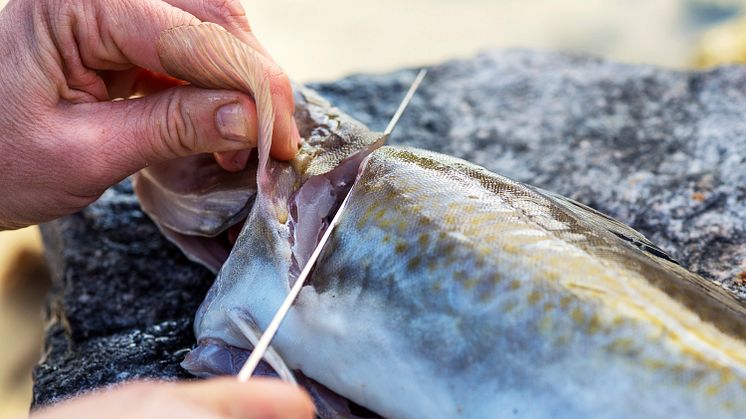
Press release -
Norwegian seafood exports exceed NOK 71 billion in 2018
Norway has exported 2 million tonnes of seafood with a total value of NOK 71 billion so far this year. This represents a volume increase of 174,000 tonnes or 8 per cent, and an increase in export value of NOK 2.3 billion or 3 per cent measured against the same period last year. Can Norwegian seafood exports pass the NOK 100 billion mark by year-end?
In September Norway exported 160,000 tonnes of seafood with a value of NOK 7.7 billion. This is a 21 per cent decrease in volume, while the export value fell by 4 per cent or NOK 307 million compared with the same month last year.
"So far this year, we have exported NOK 71 billion in value across all seafood categories. This has been driven by strong prices for cod and an increase in volume for salmon. At the same time, currency effects have been in Norway´s favour overall throughout 2018. We are therefore on track for 2018 to be a record year for Norwegian seafood exports. If we are to pass the “magical” NOK 100 billion line, then salmon prices will need to be significantly stronger in Q4, compared with the same period in 2017. At the same time, exciting developments in the herring and mackerel market also have the potential to strengthen prices” says Asbjørn Warvik Rørtveit, Director for Market Insight and Access with the Norwegian Seafood Council.
Salmon exports 4% up on 2017
So far this year, Norway has exported 759,000 tonnes of salmon worth NOK 49.4 billion. This is an increase in volume of 50,000 tonnes or 7 per cent, while the export value has increased by 4 per cent or NOK 1.7 billion from the same period last year.
"A weakening Norwegian kroner has contributed to salmon exports holding steady in September. Demand in the EU, Norway´s most important salmon export market has flattened out. Growth is primarily in Asia and Eastern Europe, and with free access to markets like Russia and China, Chile has been the most able to exploit this situation in 2018" says Paul T. Aandahl, Seafood Analyst with the Norwegian Seafood Council,.
Norway has exported 88,200 tonnes of salmon worth NOK 5.7 billion in September. There was a volume decline of 8 per cent, while the export value remains at the same level as September last year. The average price achieved for whole fresh salmon was NOK 60.96 per kg in September, compared with NOK 55.46 per kg in the same month last year. So far this year, Poland and France have bought the most salmon from Norway.
Growth in export volume for trout
Norway has exported 31,500 tonnes of trout worth NOK 2.1 billion so far this year. This is a volume increase of 22 per cent, while the value increased by 4 per cent or NOK 82 million compared to the same period last year. In September Norway exported 3,800 tonnes of trout worth NOK 246 million. Volume is at the same level as last year, while export value fell by 3 per cent or NOK 9 million. In September, Belarus and the United States have bought the most trout from Norway.
"Historically, Japan has been the most important market for Norwegian trout before Russia opened up during the 2000s. Now the United States, which in 2013 was only the 17th most important market at NOK 18 million, has grown to be the second largest market for trout, with exports worth NOK 305 million this year. Japan is in third place with export value so far this year totalling NOK 178 million”, says Paul T. Aandahl. Seafood Analyst with the Norwegian Seafood Council,
Increases for fresh cod and decreases for frozen cod
So far this year, Norway has exported 57,000 tonnes of fresh cod, including fillet, worth NOK 2.1 billion. This is a volume decline of 4 per cent, while the value increased by 3 per cent or NOK 65 million compared to the same period last year.
Norway has exported 1,400 tonnes of fresh cod, including fillet, worth a total of NOK 57 million in September. This is a volume decline of 9 per cent, while the export value remains at the same level as last year.
“The value of fresh cod is mainly driven by a 9 per cent rise in prices for fresh whole cod so far this year. At the same time we see that fresh cod has grown its share of the category with a reduction in primarily, whole frozen cod, despite the fact that cod fishing quotas are reduced. Additional factors include the incentive schemes that have led to increased out-of-season catches, as well as a record year when it comes to available cod from fish farms. According to a new doctoral dissertation at Nofima and UiT, farmed cod maintains a very high and consistent quality, which supports strong prices, especially outside of the main season”, says Ingrid Kristine Pettersen, Seafood Analyst with the Norwegian Seafood Council,
So far this year, Norway has exported 52,000 tonnes of frozen cod, including filleted, worth a total of NOK1.9 billion. Volume fell by 13 per cent, while export value remains on the same level as last year.
Norway has exported 3,900 tonnes of frozen cod, including fillet, worth NOK 161 million in September. This represents a volume decline of 31 per cent, while the export value fell by 13 per cent or NOK 24 million from September last year.
"Frozen whole cod is the product in the cod category, which has had the largest reduction in volume, and it is enough to explain a 14 per cent increase in prices so far this year. At the same time, we see that exports of frozen cod fillets, despite reduced cod quotas, have increased by 4 per cent. The biggest increase is for the UK, where high quality frozen-on-board fillets are the main product. Frozen fillet has also seen a rise in prices. The sum of this means that the overall export value for frozen cod is at about the same as last year”, says Pettersen.
Clipfish exports grow
So far this year, Norway has exported 65,000 tonnes of clipfish worth some NOK 3 billion. This is a volume increase of 3 per cent, while the value has increased by 5 per cent or NOK 138 million from the same period last year. In September Norway has exported 9,600 tonnes of clipfish with an export value of NOK 474 million. This is a volume increase of 8 per cent, while the export value increased by 16 per cent or NOK 67 million compared to September last year.
“It's sei clipfish that has helped to increase volume, and cod clipfish which has contributed to higher prices. The high quotas for sei are a contributing factor to that sei clipfish prices have decreased. At the same time, reduced volumes, as well as stable demand in our markets has been the reason why cod clipfish prices have risen”, says Ingrid Kristine Pettersen.
Increases in salted fish exports
So far this year, Norway has exported 25,000 tonnes of salted fish with a total value of NOK 1.2 billion. This is a volume increase of 5 per cent, while the value increased by 18 per cent or NOK 183 million compared with the same period last year. In September, Norway exported 1,300 tonnes of salted fish to a value of NOK 61 million. Export volumes are at the same level as last year, while export values increased by 11 per cent or NOK 6 million.
"We have seen a volume increase in salted fish which both is exported to countries such as Spain, and which is an input to clipfish production in Portugal. High demand and a weaker Norwegian kroner against the Euro has contributed to a marked price increase for saltfish generally”, explains Ingrid Kristine Pettersen.
Price inflation for dried fish
So far this year, Norway has exported 3,200 tonnes of dried fish worth a total of NOK 436 million. This is a volume increase of 13 per cent, while the export value increased by 14 per cent. In September, Norway has exported 451 tonnes of dried fish worth a total of NOK 64 million. This corresponds to a volume reduction of 8 per cent and a 13 per cent drop in export value.
“Dried codfish which is the largest product in the dry fish category has seen weaker pricing this year. Therefore, it is positive that in September we saw a price increase of 7 per cent compared with the same period last year. There has been lower production volumes of dried fish this year due to a cold winter, which means we expect to see continued price growth throughout the year” says Ingrid Kristine Pettersen.
"We have, together with Norwegian dried fish producers, just experienced a fantastic week in Italy. In Naples we conducted interesting in-depth market research to better understand the Italian consumer, and learned more about how to communicate their enthusiasm for the Norwegian dried fish product”, said Trym Eidem Gundersen with the Norwegian Seafood Council´s Italian delegation.
Decreases for herring and mackerel
So far this year, Norway has exported 199,000 tonnes of herring worth NOK 1.8 billion. This is a volume increase of 13 per cent and a decrease in export value of 6 per cent or NOK 103 million. In September Norway has exported 18,000 tonnes of herring with a total value of NOK 179 million. This represents a volume increase of 50 per cent, while the total export value increased by 28 per cent or NOK 39 million.The largest markets for herring so far this year have been Germany, Poland and Lithuania.
"The North Sea herring quotas have risen, which has resulted in a growth in volume for September”, says Seafood Analyst Paul T. Aandahl.
So far this year, Norway has exported 93 300 tonnes of mackerel worth NOK 1.2 billion. This is a volume decline of 31 per cent, and a fall in value of 27 per cent or NOK 463 million. In September, Norway has exported 7,000 tonnes of mackerel worth a total of NOK 105 million. This is a volume decline of 74 per cent, while the export value fell by 68 per cent or NOK 225 million. The largest markets for mackerel this year have been Japan, China and South Korea.
"The reduced exports can be explained by lower supply and poor fishing conditions, which has effectively delayed the start of the mackerel fishing season," says Paul T Aandahl.
Growth for king crab and prawns
So far this year, Norway has exported 1,500 tonnes of king crab worth NOK 437 million. This represents a volume increase of 7 per cent, while export value increased by 15 per cent or NOK 58 million. The largest markets for king crab year-to-date have been South Korea, USA and the Netherlands.
In September, 120 tonnes of king crab were exported with a value of NOK38 million. This is a volume decline of 37 per cent while export value fell by 28 per cent or NOK 14 million, compared with the same period in 2017.
So far this year, 6,900 tonnes of prawns have been exported with a value of NOK 568 million. This is a volume increase of 4 per cent, while the value increased by 16 per cent or NOK 77 million. In September, 819 tonnes of shrimp were exported with an export value of NOK 71 million. This is a volume decline of 16 per cent while the value is at the same level as last year. The biggest export markets for prawnsso far this year have been Sweden, UK and Finland.
"Due to reduced cod and haddock quotas, there are several trawlers who have available capacity. Rising prices for prawns have incentivised more fishing, and with the year's high first hand prices, this has an impact on exports”, says Market Insight Analyst Josefine Voraa.
Topics
Categories
The Norwegian Seafood Council works with the Norwegian fisheries and aquaculture industries to develop markets for Norwegian seafood through local market intelligence, market development and reputational risk management. The Seafood Council is headquartered in Tromsø and maintains local representatives in twelve of Norway's most important international markets. The Norwegian seafood industry finances the activities of the Norwegian Seafood Council via a tariff on all Norwegian seafood exports.
The Norwegian Seafood Council is a public company owned by the Ministry of Trade, Industry and Fisheries.



